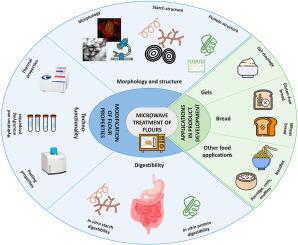微波诱导的面粉物理改性研究进展:从结构变化到产品开发
IF 11
1区 农林科学
Q1 CHEMISTRY, APPLIED
引用次数: 0
摘要
谷类食品是世界上大多数人类饮食中的主食。淀粉是谷类食品的主要成分,通常对其进行改性以增强其功能性并克服其功能局限性。微波辐射辅助的物理水热处理作为一种节能、经济的传统热处理方法,近年来受到了广泛的关注。虽然大多数研究都集中在淀粉改性上,但直接对面粉和全谷物进行改性已经成为一种有前途的策略,可以生产出营养更丰富、功能更强的成分。在这种情况下,蛋白质的作用,第二大生物聚合物,以及内源性成分之间的相互作用,在决定复杂淀粉基质的行为是非常感兴趣的。本文综述了面粉和谷物微波处理的最新进展,重点介绍了淀粉和蛋白质的结构和功能变化,以及这些变化对产品开发的影响。MW处理已被证明可以有效地改变这两种生物聚合物的形态和结构。这导致了功能的变化,这取决于植物来源和处理条件。这些修饰有效地提高了谷类食品的质量,特别是无麸质面包。总的来说,MW技术提供了一种有前途的绿色战略,用于开发定制的,针对特定饮食需求量身定制的功能性成分,在食品工业中的应用越来越广泛。本文章由计算机程序翻译,如有差异,请以英文原文为准。

Advances in microwave-induced physical modification of flours: From structural changes to product development
Cereal-based products are staple foods in most human diets worldwide. Starch, the main component of cereals, is commonly modified to enhance its functionality and overcome its functional limitations. Physical hydrothermal treatment assisted by microwave (MW) radiation has recently gained considerable attention as an energy-efficient and cost-efficient alternative to traditional thermal methods. While most studies have focused on starch modification, the direct modification of flours and whole grains has emerged as a promising strategy for producing more nutrient-dense ingredients with enhanced functionality. In this context, the role of proteins, the second major biopolymers, and the interplay between endogenous components in determining the behaviour of complex starchy matrices is of great interest. This review explores recent advances in MW treatment of flours and grains, with particular emphasis on the structural and functional changes in starch and proteins, and the implications of these changes for product development. MW treatment has been shown to effectively alter the morphology and structure of both biopolymers. This led to modifications in functionality that varied depending on the botanical source and treatment conditions. These modifications effectively enhance the quality of cereal-based food products, particularly gluten-free bread. Overall, MW technology offers a promising green strategy for developing customised, functional ingredients tailored to specific dietary needs, with growing relevance to broader applications in the food industry.
求助全文
通过发布文献求助,成功后即可免费获取论文全文。
去求助
来源期刊

Food Hydrocolloids
工程技术-食品科技
CiteScore
19.90
自引率
14.00%
发文量
871
审稿时长
37 days
期刊介绍:
Food Hydrocolloids publishes original and innovative research focused on the characterization, functional properties, and applications of hydrocolloid materials used in food products. These hydrocolloids, defined as polysaccharides and proteins of commercial importance, are added to control aspects such as texture, stability, rheology, and sensory properties. The research's primary emphasis should be on the hydrocolloids themselves, with thorough descriptions of their source, nature, and physicochemical characteristics. Manuscripts are expected to clearly outline specific aims and objectives, include a fundamental discussion of research findings at the molecular level, and address the significance of the results. Studies on hydrocolloids in complex formulations should concentrate on their overall properties and mechanisms of action, while simple formulation development studies may not be considered for publication.
The main areas of interest are:
-Chemical and physicochemical characterisation
Thermal properties including glass transitions and conformational changes-
Rheological properties including viscosity, viscoelastic properties and gelation behaviour-
The influence on organoleptic properties-
Interfacial properties including stabilisation of dispersions, emulsions and foams-
Film forming properties with application to edible films and active packaging-
Encapsulation and controlled release of active compounds-
The influence on health including their role as dietary fibre-
Manipulation of hydrocolloid structure and functionality through chemical, biochemical and physical processes-
New hydrocolloids and hydrocolloid sources of commercial potential.
The Journal also publishes Review articles that provide an overview of the latest developments in topics of specific interest to researchers in this field of activity.
 求助内容:
求助内容: 应助结果提醒方式:
应助结果提醒方式:


